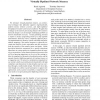Free Online Productivity Tools
i2Speak
i2Symbol
i2OCR
iTex2Img
iWeb2Print
iWeb2Shot
i2Type
iPdf2Split
iPdf2Merge
i2Bopomofo
i2Arabic
i2Style
i2Image
i2PDF
iLatex2Rtf
Sci2ools
MICRO
2006
IEEE
2006
IEEE
Virtually Pipelined Network Memory
We introduce virtually-pipelined memory, an architectural technique that efficiently supports high-bandwidth, uniform latency memory accesses, and high-confidence throughput even under adversarial conditions. We apply this technique to the network processing domain where memory hierarchy design is an increasingly challenging problem as network bandwidth increases. Virtual pipelining provides a simple to analyze programing model of a deep pipeline (deterministic latencies) with a completely different physical implementation (a memory system with banks and probabilistic mapping). This allows designers to effectively decouple the analysis of their algorithms and data structures from the analysis of the memory buses and banks. Unlike specialized hardware customized for a specific data-plane algorithm, our system makes no assumption about the memory access patterns. In the domain of network processors this will be of growing importance as the size of the routing tables, the complexity o...
| Added | 12 Jun 2010 |
| Updated | 12 Jun 2010 |
| Type | Conference |
| Year | 2006 |
| Where | MICRO |
| Authors | Banit Agrawal, Timothy Sherwood |
Comments (0)

